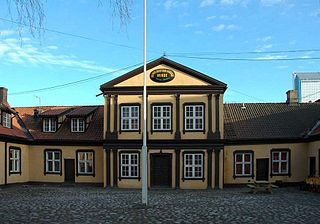
Christiania Dampkjøkken was a kitchen and catering company established in Christiania, Norway, in 1857. They opened their kitchen in 1858, in Torggata 8 in Christiania. The company philosophy was to offer cheap quality food, served in large open rooms. The company building was designed by architect Georg Andreas Bull. The kitchen was popular among both poor and wealthy persons. Among the guests who later became famous cultural personalities were Knut Hamsun, Henrik Ibsen, Aasmund Olavsson Vinje, Hans Jæger, Arne Garborg and Christian Skredsvig. Among royal visitors were King Oscar II, German Emperor Wilhelm II and Prince Henry of Prussia. [1] [2] The company profile gradually developed from soup kitchen into catering, and was eventually taken over by the company SAS Service Partner.

A soup kitchen, meal center, or food kitchen is a place where food is offered to the hungry usually for free or sometimes at a below-market price. Frequently located in lower-income neighborhoods, soup kitchens are often staffed by volunteer organizations, such as church or community groups. Soup kitchens sometimes obtain food from a food bank for free or at a low price, because they are considered a charity, which makes it easier for them to feed the many people who require their services.

Catering is the business of providing food service at a remote site or a site such as a hotel, hospital, pub, aircraft, cruise ship, park, filming site or studio, entertainment site, or event venue.

Oslo is the capital and most populous city of Norway. It constitutes both a county and a municipality. Founded in the year 1040 as Ánslo, and established as a kaupstad or trading place in 1048 by Harald Hardrada, the city was elevated to a bishopric in 1070 and a capital under Haakon V of Norway around 1300. Personal unions with Denmark from 1397 to 1523 and again from 1536 to 1814 reduced its influence, and with Sweden from 1814 to 1905 it functioned as a co-official capital. After being destroyed by a fire in 1624, during the reign of King Christian IV, a new city was built closer to Akershus Fortress and named Christiania in the king's honour. It was established as a municipality (formannskapsdistrikt) on 1 January 1838. The city's name was spelled Kristiania between 1877 and 1897 by state and municipal authorities. In 1925 the city was renamed Oslo.














